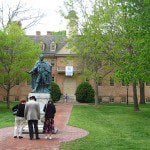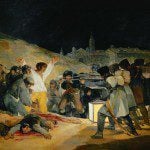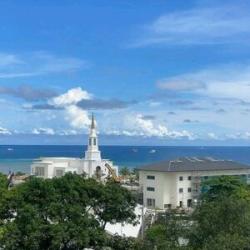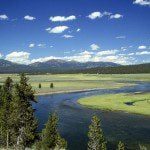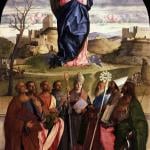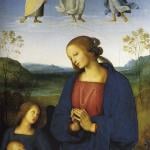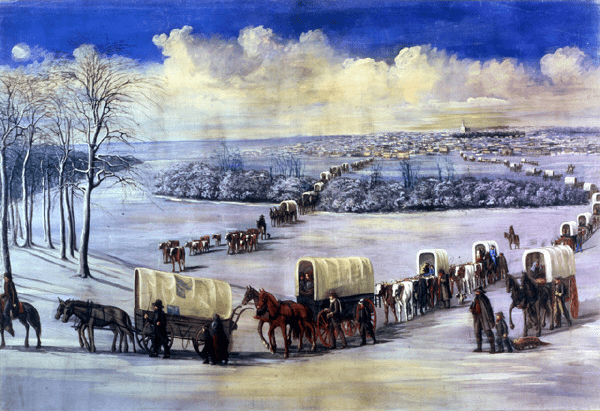
24 July, for people who reside in Utah and for many members of the Church of Jesus Christ of Latter-day Saints worldwide, is “Pioneer Day.” It commemorates the entry of Brigham Young and the first group of Latter-day Saint pioneers — the advance or vanguard party — into the Valley of the Great Salt Lake on 24 July 1847 after the forced expulsion of their people from Nauvoo, Illinois, and other (mostly adjacent) locations in the eastern United States and the roughly 70,000 other pioneers who followed them before the completion of the transcontinental railroad. There will be parades, rodeos, fireworks (and resultant wildfires), barbecues, and other festivities in celebration of the holiday. In Utah, many municipal and county offices, many businesses, and all state-run government offices will close for the day.
Amidst all of the busyness and activity, and particularly, perhaps, on the Sundays before and/or after Pioneer Day, there are also sometimes occasional moments for reflection. (I’m deeply grateful, too, to the person who had the brilliant idea of reenacting “handcart treks,” which are now so familiar among our youth. See, for example, “Church Historian Inspires Youth on Trek Across the Wyoming Mormon Trail: Elder Kyle S. McKay and his wife, Jennifer, join about 150 youth on a pioneer trek experience”). With that in mind, I would like to offer a few hasty thoughts here:
First of all, not every Nauvoo Latter-day Saint came west. (Some obvious examples of those who remained behind are Emma Smith, Joseph’s widow, and her children; the widowed Lucy Mack Smith, Joseph and Hyrum’s mother; and William Smith, the brother of the Prophet and the Patriarch.) Many of those who remained in the Midwest and East presumably drifted away from the Restoration. Others joined offshoots of the mainstream Church (e.g., the so-called “Strangite”) group or, eventually, coalesced to become, first, the Reorganized Church of Jesus Christ of Latter Day Saints and then, much more recently, the Community of Christ. Over the past several decades, the latter has been moving (from my perspective) in the direction of a rather liberal or progressive Protestantism, which has generated still further schisms.
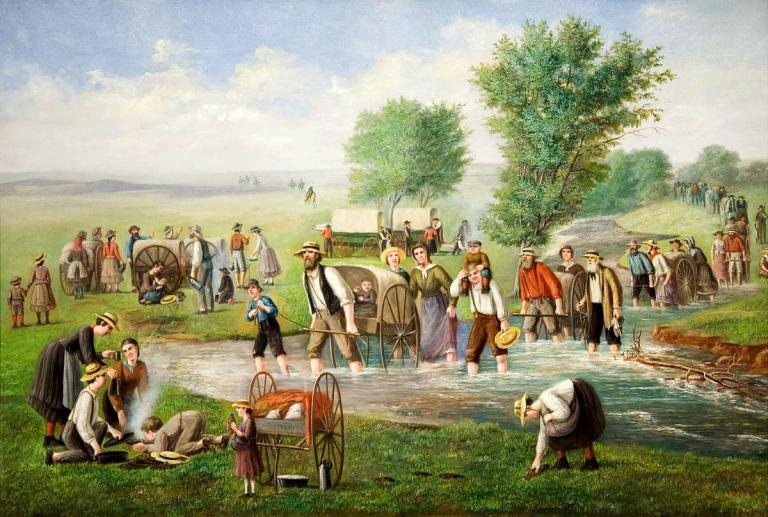
(Wikimedia Commons public domain image)
The Latter-day Saint pioneers weren’t “rugged individualists,” traveling alone and in isolation, let alone anti-social outcasts on the margins. They set out with a plan, organized into companies. They took the time to acquire or construct the wagons and the other equipment that they would need, and to think carefully through the supplies that would be required. They traveled in society, as a community. On more than few occasions, they paused or left somebody behind to prepare the way, to build facilities, and to plant crops for those who would follow them. They kept careful records, not merely to satisfy later historical curiosity but to benefit any of their fellow Saints who hoped to travel the same path thereafter. And when they finally arrived at their Great Basin goal, they were often sent out once again as organized communities to found cities and towns, not just to establish scattered homesteads.
From a Wikipedia entry:
The roadometer was a 19th-century device like an odometer for measuring mileage, mounted on a wagon wheel. One such device was invented in 1847 by William Clayton, Orson Pratt, and Appleton Harmon, pioneers of the Church of Jesus Christ of Latter-day Saints.
Brass odometers were used by many pioneers making the westward trek in the 1840s. However, the design of Clayton, Pratt, and Harmon’s odometer was new. In 1847, William Clayton accompanied the first expedition to the Utah Territory as a writer and record-keeper. He initially counted revolutions of a wagon wheel to calculate the distance they had travelled. He tired of counting wheel revolutions and wanted a device that could measure the distance a wagon travelled. Clayton asked Orson Pratt if it would be possible to make such a device, and Pratt created the design. Harmon carved the gears out of wood and may have further refined the design. They started using the roadometer around May 12. Three hundred and sixty revolutions of the wagon wheel equaled one mile.
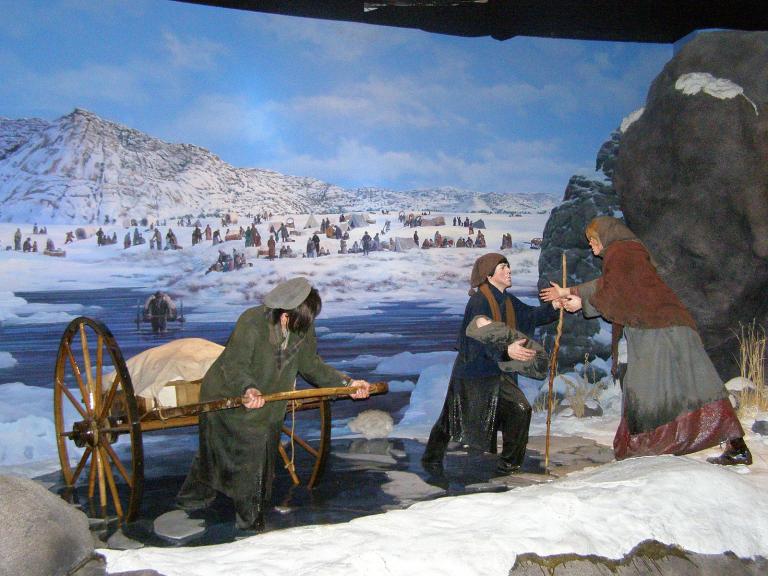
The Latter-day Saint pioneers forged their own path, in many places following their own separate trail. Partly, of course, this was because their end-goal was different than that of the California Forty-Niners, who sought gold, or that of the folks on the Oregon trail, who sought land. But it was also because, in some areas (e.g., in choosing the northern side of the Platte River rather than the southern side), they wished to avoid too much contact (and potential conflict) with non-Latter-day Saint wagon trains that were also moving westward.
Those who went West did so under the leadership of living apostles and prophets. I see this not just as historically important for us today but as metaphorically so, just as their westward exodus can serve as a symbol of our own earthly pilgrimage through life. (We still sing “Come, Come Ye Saints” today not merely as a historical tribute but as if its lyrics have meaning for our modern journeys, both individual and collective. See this remarkable YouTube video, which moves me to tears every time I watch it. And others can so use it, as well. See, for example, “Why a Black baptist church adopted ‘Come, Come Ye Saints’: ‘It’s one of our staples’: The Rev. Dr. Amos C. Brown, ‘a walking history book,’ requested the Latter-day Saint pioneer anthem for his pastor emeritus designation service.”)
We too are led by prophets and apostles. And if we stay with the group, not wandering off into strange paths where hostile enemies may lurk and dangerous animals may prowl, our odds of making it to “the place which God prepared” will be much enhanced. However, alas, some will not reach our destination. The path is difficult, over plains and mountains and through great heat and bitter cold, and we sustain casualties along the way. Sometimes, the pain of such losses is almost too much to bear.
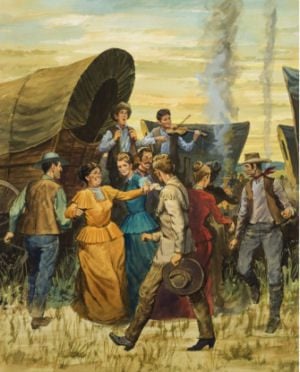
It wasn’t all work along the way. It wasn’t always, or even often, grim. There was music and courtship. There were dances. But they did make a serious effort, as much as ordinary mortals under great stress can make, to live the commandments. They tried, for example, to keep the Sabbath Day holy.
Outwardly, they didn’t look all that terribly different from other people who were migrating to the West, but they were the “wandering camp of Israel,” led in an “exodus” by an “American Moses” and animated by a different spirit than many of the land-hungry farmers and gold-seekers whom they would meet on the trail.
Theirs is a legacy well worth considering and pondering, and not merely for those who are their literal biological descendants. I’m firmly convinced that it was the trek westward and the experience of settling the Great Basin West that formed the Latter-day Saints into something like an ethnic group (resembling the Jews in a certain way) rather than merely another religious denomination (like the Methodists and the Presbyterians).
The epic story of the early Restoration, the westward migration, and our history of colonizing the West give a unique texture to “Mormonism” and to each family with that heritage, whether genetic or by adoption. We have a history — a historical “myth,” if you will (by which I don’t mean a “falsehood” but rather an archetypal narrative) — that is exceptional in both its nature and its content. Decades ago, while browsing through the then-new Harvard Encyclopedia of American Ethnic Groups (or whatever it was called) in a library in Cairo, I was surprised and quickly delighted to see that Latter-day Saints were listed as an “ethnic group,” which I thought very perceptive. Years later, Joel Kotkin took the same insight in a portion of his fascinating book Tribes and developed it in an interesting direction.
And recent converts also inherit the legacy of the pioneers, and the hymns and stories and art that go with it, creating a culture that has continued to expand and to assimilate new arrivals. (I hope that the original pioneers are allowed to see such astonishing things as this, of which they almost certainly never so much as dreamed: “All are pioneers: Mongolian youth blaze a trail of faith on trek: Whether in Utah or Mongolia, the spirit of the pioneers is not limited to wagons and the 1800s.”). The pioneer experience welded Latter-day Saints together as a people, such that even those who (sadly) fall away from the Church remain, in many cases, distinctively and irretrievably “Mormon.” I expect that few of those who, for whatever reason, leave the Episcopal Church spend hours each week running anti-Episcopal websites and posting anonymously on furiously bitter anti-Episcopal message boards.
Posted from Williamsburg, Virginia


